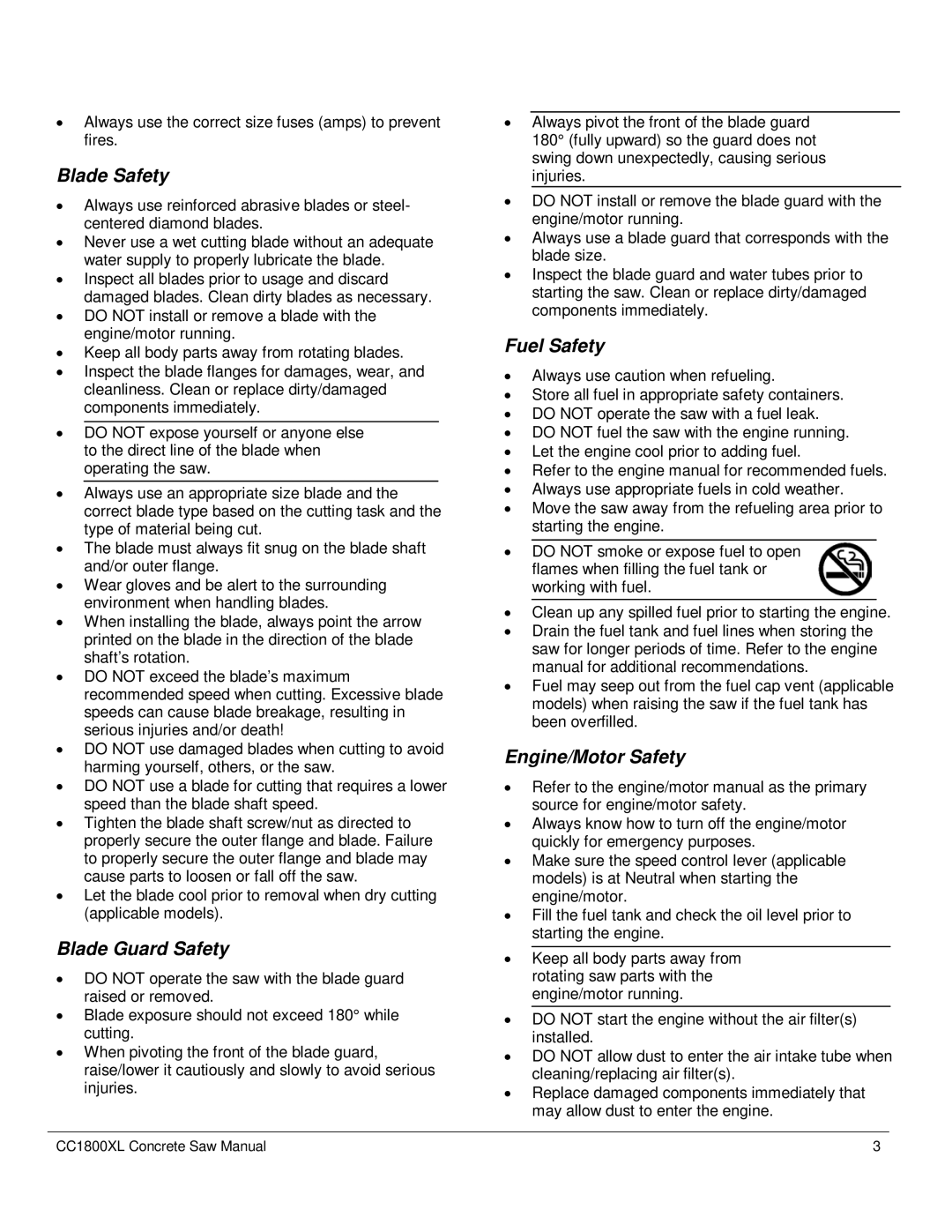
•Always use the correct size fuses (amps) to prevent fires.
Blade Safety
•Always use reinforced abrasive blades or steel- centered diamond blades.
•Never use a wet cutting blade without an adequate water supply to properly lubricate the blade.
•Inspect all blades prior to usage and discard damaged blades. Clean dirty blades as necessary.
•DO NOT install or remove a blade with the engine/motor running.
•Keep all body parts away from rotating blades.
•Inspect the blade flanges for damages, wear, and cleanliness. Clean or replace dirty/damaged components immediately.
•DO NOT expose yourself or anyone else to the direct line of the blade when operating the saw.
•Always use an appropriate size blade and the correct blade type based on the cutting task and the type of material being cut.
•The blade must always fit snug on the blade shaft and/or outer flange.
•Wear gloves and be alert to the surrounding environment when handling blades.
•When installing the blade, always point the arrow printed on the blade in the direction of the blade shaft’s rotation.
•DO NOT exceed the blade’s maximum recommended speed when cutting. Excessive blade speeds can cause blade breakage, resulting in serious injuries and/or death!
•DO NOT use damaged blades when cutting to avoid harming yourself, others, or the saw.
•DO NOT use a blade for cutting that requires a lower speed than the blade shaft speed.
•Tighten the blade shaft screw/nut as directed to properly secure the outer flange and blade. Failure to properly secure the outer flange and blade may cause parts to loosen or fall off the saw.
•Let the blade cool prior to removal when dry cutting (applicable models).
Blade Guard Safety
•DO NOT operate the saw with the blade guard raised or removed.
•Blade exposure should not exceed 180° while cutting.
•When pivoting the front of the blade guard, raise/lower it cautiously and slowly to avoid serious injuries.
•Always pivot the front of the blade guard 180° (fully upward) so the guard does not swing down unexpectedly, causing serious injuries.
•DO NOT install or remove the blade guard with the engine/motor running.
•Always use a blade guard that corresponds with the blade size.
•Inspect the blade guard and water tubes prior to starting the saw. Clean or replace dirty/damaged components immediately.
Fuel Safety
•Always use caution when refueling.
•Store all fuel in appropriate safety containers.
•DO NOT operate the saw with a fuel leak.
•DO NOT fuel the saw with the engine running.
•Let the engine cool prior to adding fuel.
•Refer to the engine manual for recommended fuels.
•Always use appropriate fuels in cold weather.
•Move the saw away from the refueling area prior to starting the engine.
•DO NOT smoke or expose fuel to open flames when filling the fuel tank or working with fuel.
•Clean up any spilled fuel prior to starting the engine.
•Drain the fuel tank and fuel lines when storing the saw for longer periods of time. Refer to the engine manual for additional recommendations.
•Fuel may seep out from the fuel cap vent (applicable models) when raising the saw if the fuel tank has been overfilled.
Engine/Motor Safety
•Refer to the engine/motor manual as the primary source for engine/motor safety.
•Always know how to turn off the engine/motor quickly for emergency purposes.
•Make sure the speed control lever (applicable models) is at Neutral when starting the engine/motor.
•Fill the fuel tank and check the oil level prior to starting the engine.
•Keep all body parts away from rotating saw parts with the engine/motor running.
•DO NOT start the engine without the air filter(s) installed.
•DO NOT allow dust to enter the air intake tube when cleaning/replacing air filter(s).
•Replace damaged components immediately that may allow dust to enter the engine.
CC1800XL Concrete Saw Manual | 3 |
